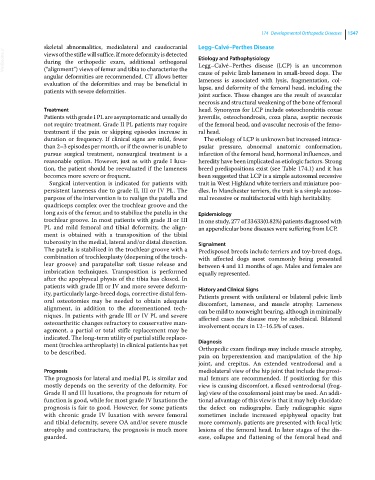Page 1609 - Clinical Small Animal Internal Medicine
P. 1609
174 Developmental Orthopedic Diseases 1547
skeletal abnormalities, mediolateral and caudocranial Legg–Calvé–Perthes Disease
VetBooks.ir views of the stifle will suffice. If more deformity is detected Etiology and Pathophysiology
during the orthopedic exam, additional orthogonal
Legg–Calvé–Perthes disease (LCP) is an uncommon
(“alignment”) views of femur and tibia to characterize the
angular deformities are recommended. CT allows better cause of pelvic limb lameness in small‐breed dogs. The
lameness is associated with lysis, fragmentation, col-
evaluation of the deformities and may be beneficial in lapse, and deformity of the femoral head, including the
patients with severe deformities.
joint surface. These changes are the result of avascular
necrosis and structural weakening of the bone of femoral
Treatment head. Synonyms for LCP include osteochondritis coxae
Patients with grade I PL are asymptomatic and usually do juvenilis, osteochondrosis, coxa plana, aseptic necrosis
not require treatment. Grade II PL patients may require of the femoral head, and avascular necrosis of the femo-
treatment if the pain or skipping episodes increase in ral head.
duration or frequency. If clinical signs are mild, fewer The etiology of LCP is unknown but increased intraca-
than 2–3 episodes per month, or if the owner is unable to psular pressure, abnormal anatomic conformation,
pursue surgical treatment, nonsurgical treatment is a infarction of the femoral head, hormonal influences, and
reasonable option. However, just as with grade I luxa- heredity have been implicated as etiologic factors. Strong
tion, the patient should be reevaluated if the lameness breed predispositions exist (see Table 174.1) and it has
becomes more severe or frequent. been suggested that LCP is a simple autosomal recessive
Surgical intervention is indicated for patients with trait in West Highland white terriers and miniature poo-
persistent lameness due to grade II, III or IV PL. The dles. In Manchester terriers, the trait is a simple autoso-
purpose of the intervention is to realign the patella and mal recessive or multifactorial with high heritability.
quadriceps complex over the trochlear groove and the
long axis of the femur, and to stabilize the patella in the Epidemiology
trochlear groove. In most patients with grade II or III In one study, 277 of 33 633(0.82%) patients diagnosed with
PL and mild femoral and tibial deformity, the align- an appendicular bone diseases were suffering from LCP.
ment is obtained with a transposition of the tibial
tuberosity in the medial, lateral and/or distal direction. Signalment
The patella is stabilized in the trochlear groove with a Predisposed breeds include terriers and toy‐breed dogs,
combination of trochleoplasty (deepening of the troch- with affected dogs most commonly being presented
lear groove) and parapatellar soft tissue release and between 4 and 11 months of age. Males and females are
imbrication techniques. Transposition is performed equally represented.
after the apophyseal physis of the tibia has closed. In
patients with grade III or IV and more severe deform- History and Clinical Signs
ity, particularly large‐breed dogs, corrective distal fem- Patients present with unilateral or bilateral pelvic limb
oral osteotomies may be needed to obtain adequate discomfort, lameness, and muscle atrophy. Lameness
alignment, in addition to the aforementioned tech- can be mild to nonweight bearing, although in minimally
niques. In patients with grade III or IV PL and severe affected cases the disease may be subclinical. Bilateral
osteoarthritic changes refractory to conservative man- involvement occurs in 12–16.5% of cases.
agement, a partial or total stifle replacement may be
indicated. The long‐term utility of partial stifle replace- Diagnosis
ment (trochlea arthroplasty) in clinical patients has yet Orthopedic exam findings may include muscle atrophy,
to be described.
pain on hyperextension and manipulation of the hip
joint, and crepitus. An extended ventrodorsal and a
Prognosis mediolateral view of the hip joint that include the proxi-
The prognosis for lateral and medial PL is similar and mal femurs are recommended. If positioning for this
mostly depends on the severity of the deformity. For view is causing discomfort, a flexed ventrodorsal (frog-
Grade II and III luxations, the prognosis for return of leg) view of the coxofemoral joint may be used. An addi-
function is good, while for most grade IV luxations the tional advantage of this view is that it may help elucidate
prognosis is fair to good. However, for some patients the defect on radiographs. Early radiographic signs
with chronic grade IV luxation with severe femoral sometimes include increased epiphyseal opacity but
and tibial deformity, severe OA and/or severe muscle more commonly, patients are presented with focal lytic
atrophy and contracture, the prognosis is much more lesions of the femoral head. In later stages of the dis-
guarded. ease, collapse and flattening of the femoral head and

